What needs to change to really address the lack of health care in vulnerable communities?

(Photo by Francois Picard/AFP via Getty Images)
Health care organizations are talking about ending health disparities. They are collecting data on the identity of their patients, paying attention to social factors that influence their health, and addressing clinical practices that harm marginalized populations.
The movement is fueled by an understanding that the health care system has long underserved socially vulnerable communities, which has created disparities in health outcomes based on race, sexual orientation and socioeconomic status, to name a few.
But to truly achieve the goal of health equity, more resources need to show up in communities that have long suffered inadequate access to health care services and a range of other inequities. The depth of the problems — and solutions — span policy, technology, economics, urban and rural design, education and trust. Health care organizations can start by simply showing up.
This project, under the auspices of the 2022 Data Fellowship, seeks to create a roadmap for health care executives on where the most high-need places are in the country and what they should do about it. The analyses will merge indices that illustrate regional trends on issues such as housing, nutrition and income with the location of health care providers across the United States. It will analyze how well the industry is geographically distributed to serve the nation's most vulnerable communities.
Preliminary research has shown that social vulnerability and inadequate access to health care resources persist across urban and rural settings. Every community confronts different circumstances contributing to health disparities, suggesting solutions vary and must be tailored to meet specific needs.
For example, a rural community in Southern Texas with a predominantly Latino population is 50 miles from the nearest hospital. According to Census data, approximately one in four people in that county have incomes below the federal poverty level. What do they do when they need health care?
In the Bronx, locals don't have access to affordable housing and live in a food desert. There is no health care facility within walking distance despite the population density. How are they supposed to stay healthy?
The project will also consider how health systems develop within urban centers and whether health care services are evenly distributed to address residents' needs adequately. What considerations go into development? And how does that align with the community's health needs and health care organizations’ promises to correct longstanding disparities?
My reporting for the 2022 Data Fellowship will focus on the makeup of five communities that have the most significant social vulnerability and the worst access to health care services.
I will write about the historical context underpinning the inequities they face and the barriers to healthy living. Tapping into health care organizations already present in the region, such as local health departments, community health centers or insurers, my reporting will consider what infrastructure already exists and what more is needed. It will also feature residents' voices about their community, how they utilize health care services, what kinds of health coverage they have, and what they want their health care to look like.